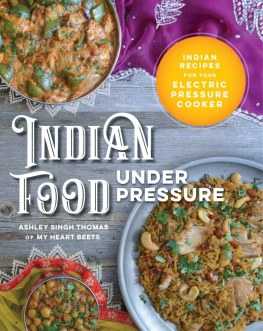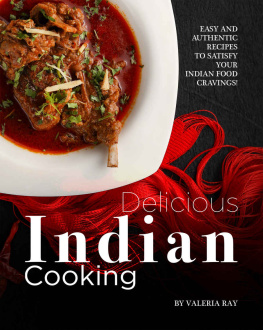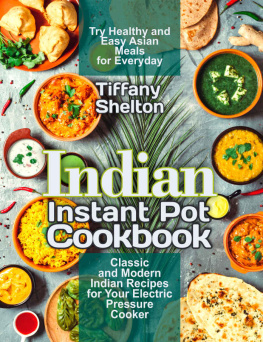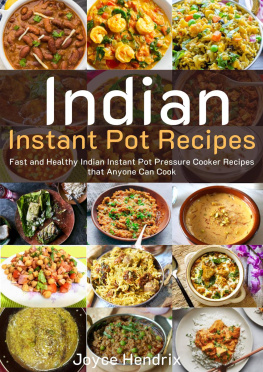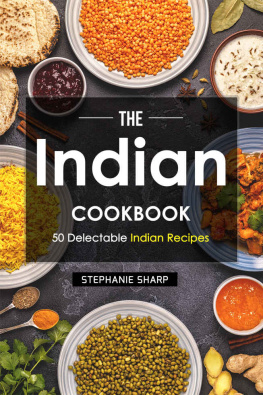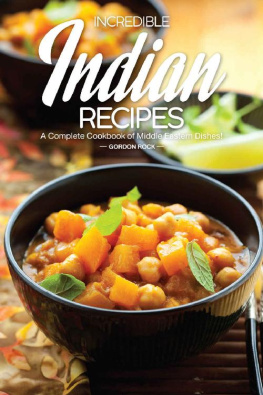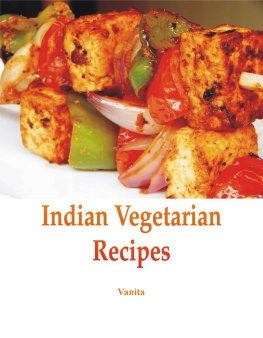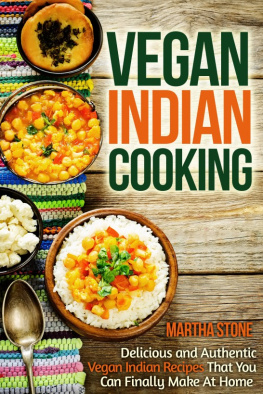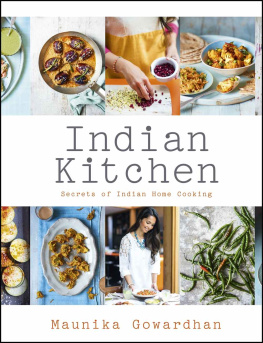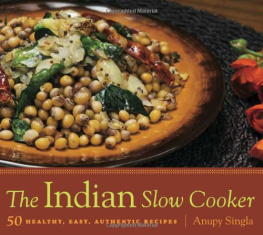Table of Contents
Indian Food
Under Pressure
Indian Recipes for
Your Electric Pressure Cooker
Ashley Singh Thomas
Copyright 2017 Ashley Singh Thomas
First Published in 2017 by My Heart Beets
All rights reserved. No part of this cookbook may be reproduced or distributed in any form or by any means, electronic or mechanical, without prior written permission from the publisher.
ISBN-10: 0-9992861-0-2
ISBN-13: 978-0-9992861-0-4
This book is for entertainment purposes. The publisher and author of this cookbook are not responsible in any manner whatsoever for any adverse effects arising directly or indirectly as a result of the information provided in this book.
Photography: Ashley Thomas
Front Cover Photography: Quelcy Creative Designs
Publishing and Design Services: MartinPublishingServices.com
Thank you for buying this ebook.
To receive more content like this from Ashley Singh Thomas, visit her blog at MyHeartBeets.com and join her Indian Cooking Facebook Community .


About the Author:
Ashley Singh Thomas
Hello! Im Ashley, the founder of My Heart Beets, a blog dedicated to flavorful, real food recipes. Even though I share a variety of recipes on my website, Indian cuisine is easily my favorite.

I grew up in an Indian household eating delicious North Indian food, and I was completely unaware of how varied Indian cuisine was until I started dating Roby. He introduced me to South Indian cuisine, specifically Keralite food, and I fell in love (with both him and the food).
It wasnt until I got married that I really felt the desire to learn my familys recipes. The problem was that when Id call to ask for measurements, my mom would tell me she cooks andaz naal which basically means she eyeballs everything. Most Indian parents dont measure ingredients (ever) and so trying to recreate recipes was really tough. Whenever Id visit home, Id follow my parents and my in-laws around the kitchen, taking notes and asking questions. I would sometimes help them as they cooked, measuring their ingredients before they threw them into the pot. I also started paying close attention to ratios as well as how things were supposed to taste. I used this information, gathered over several years, to test and develop many of the recipes that I share both on my blog and also in my books. For this particular cookbook, I have adapted all recipes to be electric pressure cooker friendly.
This book features both North and South Indian recipes. If you enjoy eating at Indian restaurants, then youll be happy to know Ive included recipes for many dishes commonly found on restaurant menus. Im obviously biased but I believe my recipes are just as good, if not better than restaurant-quality. There may be some unfamiliar recipes in this book too. I hope youll try them as they are equally delicious.
And finally, if you do like this book and want to try more recipes or want to learn a little more about me, I hope youll visit my blog, MyHeartBeets.com .
How to Use This Book:
10 Things To Know
Before You Start Cooking
1 All Multicookers Vary: I own two different electric pressure cookers and there are slight differences between them. For example, one has a manual button and the other does not. In most of my recipes, once you are done with the saut portion, you will need to press another button to begin the actual pressure cooking. All pressure cookers vary and so you may find that you need to slightly adjust the recipe instructions and cook times in this book. Make sure to read the instruction manual that came with your appliance.
2 Read Recipes in Entirety: Make sure to read through the recipes before you begin cooking so that there arent any surprises halfway through.
3 Gather Spices: Taking a minute to gather and measure all of the spices listed in a recipe before you begin can make a huge difference in the outcome of your dish. If youre not prepared, youll be searching for spices and adding them to the pot one at a time which will most definitely cause your spices to burn.
4 Prepare Ingredients: I know I specifically called out spices right before this because I believe thats crucial, but I also think its a good idea to prepare the rest of the ingredients beforehand as well. Dice onions, mince garlic, etc. Better yet, keep a jar of minced garlic or minced ginger in the fridge or freezer (I add a little oil to keep the garlic and ginger fresh). This will ensure that cooking goes smoothly.
5 Adjust to Taste: While you cant substitute everything in a recipe and expect it to taste as it should, there are some instances when you can and should adapt a recipe to suit your tastes. Feel free to change the amount of salt or chilies used in any recipe in this book. If you like your food on the saltier side, add more salt. If you want to enjoy spicier food, add more cayenne or extra green chilies. I personally like Serrano peppers, but you can use birds eye chili or jalapeos or whatever you want. I prefer my food slightly spicy, but my husband prefers his food ridiculously spicy, so he adds fresh green chilies or extra cayenne directly to his bowl. You can also adjust the consistency of a dish. If you prefer a thicker sauce, press the saut button when your dish is done to reduce the gravy. Likewise, you can add water to create a thinner curry.
6 Use fresh ingredients: Old beans take longer to cook. Fresh spices have more flavor. I try to buy whole spices when I can and grind them in a spice grinder for maximum flavor.
7 Oil: I typically use avocado oil in most of my recipes because its a very neutral oil, but you can use any neutral oil you like. If I specify a certain type of fat (coconut oil or ghee), then try to use it because the flavor will add to the dish.
8 Size Doesnt Really Matter: When it comes to cooking Indian food, the size of the tomato or the onion you use isnt going to make or break a recipe, so dont sweat it. I intentionally did not write medium or large before most ingredients because I know the majority of people dont care to measure the diameter of a tomato. When I was new to cooking, I used to really worry about this so Im sure there are some of you who might be in that position too. What Ive learned after years of cooking Indian food is that it honestly does not matter. If you like onions, use a large onion.
9 Kashmiri Chili: Long-time readers of my blog (My Heart Beets) know that I used to use Kashmiri chili in my recipes. Kashmiri chili has a very mild flavor (its not spicy at all). Its kind of like (sweet) paprika with a very light touch of cayenne. If you want to use Kashmiri chili then feel free to use it as a replacement for paprika.
10 Have Questions About a Recipe? I want to help you. My goal with this book is to make Indian cooking more approachable. Feel free to email me at . Please keep in mind that in addition to being a blogger, Im also a full-time mom, so it may take me time to reply.
Why Cook Indian Food
With an Electric Pressure Cooker?
I have been using an electric pressure cooker for several years now, but it wasnt until I became a mother that this appliance became my go-to cooking device. I have been able to adapt so many Indian recipes to be one-pot friendly, making the recipes much more approachable. I use my pressure cooker daily, sometimes multiple times a day, and when it comes to Indian cooking this is pretty much the only appliance I use these days.
Next page
